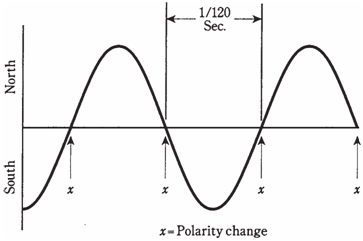Aternating-current types
You may get the idea that electromagnet can be made far stronger if, rather than using the lantern battery for the current source; you plug the wires into the wall outlet. Theoretically, it is true. In practice, you will probably blow the fuse or circuit breaker. Don't try this. The electrical circuits in some buildings are not protected adequately and it can result in fire hazard. Also, you can get a deadly shock from the 117-V utility mains.
Some electromagnets use alternating current, and these magnets will "stick" to ferromagnetic objects. But polarity of magnetic field reverses every time the direction of the current is reversed. That means there are around 120 fluctuations per second, or 60 complete north to south to north polarity changes consider the figure given below every second. If the permanent magnet, or a direct current electromagnet, is brought near either pole of an alternating current electromagnet, there will not be any net force. This is because poles will be similar half the time, and opposite half the time, generating an equal amount of attractive and repulsive force.

Figure Polarity change in an ac electromagnet.
For an alternating current electromagnet to work, the core material posses have high permeability but low retentivity. These terms are discussed as follows.